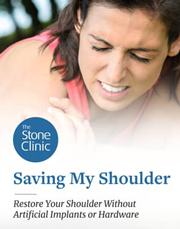Bankart Repair Rehabilitation Protocol
- Use of a sling only as needed or prescribed - Okay to shower once dressings are changed (Day 1)
- Arm is restricted from these movements for 4 weeks:
- extension (backwards) past the plane of the body
- External rotation (arm rotation outwards) greater than 0° (straight in front); extensive repairs may require more restrictions
- For posterior repairs, avoid any internal rotation (turning in) past the body
- No passive forceful stretching into external rotation/extension for 3 months following an anterior repair and into internal rotation for a posterior repair
- Good posture is critical throughout the rehabilitation process to improve healing and decrease the risk of developing poor mechanics
- Aerobic conditioning throughout the rehabilitation process
- M.D./nurse followups Day 2, Day 14, 1 month, 4 months, 6 months and 1 year.
- All active exercises should be carefully monitored to minimize substitution or compensation
Week 1
- Nurse visit Day 2 to inspect surgical dressing and review home program.
- Ice shoulder every 2 hours for 1520 min during wake hours for first 2 weeks.
Manual:
- effleurage
- soft tissue mobilization to surrounding musculature
- gentle scapula glides.
Exercise:
Home program to consist of:
- Elbow flexion / extension
- wrist and forearm strengthening
- cervical stretches
- postural education and exercises.
*It is important to come out of the sling frequently to bend and straighten elbow for 1015 repetitions each time tominimize arm and hand swelling.
Stationary bike, stair machine, and Versa Climber without putting weight on arms.
Goals:
- Decrease pain and edema.
- Initiate passive range of motion to shoulder per restrictions (anterior no ER/Ext, posteriorno IR).
- Passive range of motion < 50 degrees flexion/scaption.
- Full elbow range of motion.
Weeks 2-4
Manual:
- effleurage
- soft tissue mobilization to surrounding musculature
- gentle scapula glides.
- Pain control(i.e. cryotherapy, massage, and electric stimulation).
Goals:
- Decrease pain and edema.
- Passive range of motion < 90 degrees flexion/scaption.
Weeks 4 - 6
MD appointment at 4 weeks, discharge sling if approved by MD.
Manual:
Soft tissue mobilization to surrounding musculature, initiate scar mobilization to surgical incisions ifcompletely closed.
Exercise:
Passive and active assisted flexion out to the scapular plane as tolerated (cane exercises, wall walking,table slide).
- Progress to active exercises from flexion into the scapular plane against gravity as tolerated
*No resistance until able to perform 30 reps with perfect mechanics. - Isotonic wrist, forearm, and scapular exercises.
- Theraband resisted pulldowns from the front and the scapular plane; elbow flexion; submaximal isometrics (as dictated by pain); active scapular elevation, depression, and retraction exercises; light weight bearing
- Upper body ergometer with light to no resistance only.
- Add proprioceptive training (alphabet writing, fine motor skills, work / sport specific).
Goals:
- Out of sling; minimal resting pain.
- Initiate active range of motion flexion/scaption.
Weeks 6 - 8
Manual:
Continue with soft tissue mobilization, range of motion.
Exercise:
- Continue to increase active range of motion exercises as tolerated (serratus anterior, upper and lower trapezius); add eccentrics into protected ranges.
- Okay to begin LIGHT stretching into external rotation.
- Okay to begin LIGHT glenohumeral joint mobilization.
- Okay to add light resistance internal rotation exercises from 0 degrees to the body only
- Increase proprioceptive training (prone on elbows, quadruped position / "on all four's"for rhythmic stabilization).
- Upper body ergometer (UBE) with increasing resistance.
Goals:
- Range of motion greater than 80% of normal, initiate tolerance to hand behind head/back exercises.
- Initiate jogging, road cycling, and standing arm resistance exercises in the pool.
Weeks 8 - 12
- Emphasis on regaining strength and endurance.
- Light proprioceptive neuromuscular facilitation (PNF) patterns.
- active range of motion exercises to include internal rotation and external rotation as motion allows, lateral raises and supraspinatus isolation, rower with a high seat, decline bench press, military press in front of body.
- Running, road or mountain biking; no activities with forceful, ballistic arm movement.
3 - 6 Months:
MD appointment at 12 weeks.
- Aggressive stretching; begin strenuous resistive exercises.
- Add light throwing exercises with attention to proper mechanics.
6 Months:
- Increase throwing program/sport-specific program. Focus on return to sports as mechanics, conditioning, and strength allow.
NOTE: All progressions are approximations and should be used as a guideline only. Progression will be based on individual patient presentation, which is assessed throughout the treatment process.
Don't Know Why Your Shoulder Hurts? Use our Shoulder Pain Symptom Checker to learn more about your symptoms and possible injury conditions.
